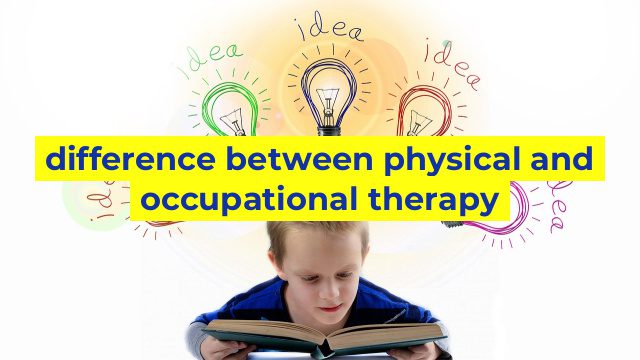The Difference Between Physical Therapy and Occupational Therapy
Physical therapy and occupational therapy are two very important forms of rehabilitation that focus on helping patients recover from injuries or disabilities. Although they are both parts of the larger field of rehabilitation therapy, there are distinct differences in the goals, methods, and focus of these two approaches. In this article, we will explore the main differences between physical therapy and occupational therapy.
Goals of Physical Therapy
The main goal of physical therapy is to help patients improve their physical function, mobility, and strength. Physical therapists work with patients to relieve pain, improve range of motion, and restore function by targeting specific muscles and joints. They use a variety of exercises, stretches, and techniques to achieve these goals, including manual therapy, ultrasound, electrical stimulation, and other treatments.
Goals of Occupational Therapy
The goal of occupational therapy is to help patients regain their ability to perform daily activities independently. This can include activities such as getting dressed, cooking, cleaning, and other tasks of daily living. Occupational therapists work with patients to develop strategies and techniques that help them overcome physical or cognitive barriers that prevent them from performing these tasks.
Focus of Physical Therapy
Physical therapy is often focused on the physical aspects of rehabilitation. Physical therapists work to improve strength, functionality, and mobility in specific areas of the body. This may involve reducing pain, increasing range of motion, and improving flexibility.
Focus of Occupational Therapy
In contrast, occupational therapy has a broader focus that includes both physical and cognitive aspects of rehabilitation. Occupational therapists work to help patients develop the skills and strategies they need to perform activities of daily living. This may involve modifying the environment, teaching new methods for performing tasks, or adapting equipment to make it easier for patients to function.
Conclusion
Although physical therapy and occupational therapy share some similarities, they are distinct approaches to rehabilitation therapy. Physical therapy focuses on improving physical function, mobility, and strength, while occupational therapy addresses both physical and cognitive barriers to daily living. Whether you need physical therapy or occupational therapy, working with a skilled and experienced therapist can help you achieve your goals and improve your quality of life.
Table difference between physical and occupational therapy
| Category | Physical Therapy | Occupational Therapy |
|---|---|---|
| Definition | Physical therapy focuses on improving mobility and function through therapeutic exercises, stretches, and other techniques. | Occupational therapy focuses on helping patients achieve daily living and work-related skills necessary for independence and quality of life. |
| Scope of Practice | Physical therapists work with patients to improve overall physical function, mobility, and movement. They may also help manage pain and prevent further injury. | Occupational therapists work with patients to improve fine motor skills, cognitive abilities, and activities of daily living. They may also assess and modify the patient’s environment to assist with functional tasks. |
| Conditions Treated | Physical therapists treat a wide range of conditions, including sports injuries, joint pain, and neurological disorders like stroke and Parkinson’s disease. | Occupational therapists treat conditions such as stroke, traumatic brain injury, and developmental disorders like autism spectrum disorder. |
| Modalities Used | Physical therapists may use modalities such as ultrasound, electrical stimulation, and hot and cold therapy to help patients manage pain and improve function. | Occupational therapists may use techniques such as adaptive equipment, sensory integration therapy, and cognitive retraining to help patients achieve daily living and work-related tasks. |
| Education Required | Physical therapists require a Doctor of Physical Therapy (DPT) degree and state licensure. | Occupational therapists require a Master’s degree in occupational therapy and state licensure. |
